Monitoring of Fiber-Reinforced Composite Single-Lap Joint with Electromechanical Impedance of Piezoelectric Transducer
Abstract
:1. Introduction
2. Theoretical Principles
3. Experimental Set-Up
4. Results and Discussion
4.1. Quasi-Static Behavior of Single-Lap Joint Analysis
4.2. Characterization of Single-Lap Joint Condition with RMSD Index
4.3. Data Processing Scale Reduction Method for Single-Lap Joint Monitoring
5. Conclusions
Author Contributions
Funding
Conflicts of Interest
Nomenclature
| Complex symbol | |
| Angular frequency (rad·s−1) | |
| Capacitance symbol (F) | |
| Dielectric constant (F·m−1) | |
| Length of the square PZT (mm) | |
| Thickness of circular PZT (mm) | |
| Coupling coefficient | |
| Piezoelectric strain constant (PC·N−1) | |
| Young’s modulus (N·m−2) | |
| Poisson ratio | |
| Wavenumber (m−1) | |
| Phase velocity (m·s−1) | |
| Damage-non-sensitive component in admittance model (S) | |
| Damage-sensitive component in admittance model (S) | |
| Coupling mechanical admittance (S) | |
| Density (kg·m−3) | |
| Mechanical loss factor | |
| Dielectric loss factor | |
| Effective driving point impedance of PZT under short-circuited condition (N·s/m) | |
| Effective driving point impedance of host structure (N·s/m) | |
| Coupling mechanical impedance (Ω) | |
| Real part of ESMI signatures | |
| Imaginary part of ESMI signatures | |
| SV | Specific value of two RMSD values in adjacent testing states |
References
- Heidarpour, F.; Farahani, M.; Ghabezi, P. Experimental investigation of the effects of adhesive defects on the single lap joint strength. Int. J. Adhes. Adhes. 2018, 80, 128–132. [Google Scholar] [CrossRef]
- Li, J.; Yan, Y.; Liang, Z.; Zhang, T. Experimental and numerical study of adhesively bonded CFRP scarf-lap joints subjected to tensile loads. J. Adhes. 2016, 92, 1–17. [Google Scholar] [CrossRef]
- Bhanushali, R.; Ayre, D.; Nezhad, H.Y. Tensile response of adhesively bonded composite-to-composite single-lap joints in the presence of bond deficiency. Procedia CIRP 2017, 59, 139–143. [Google Scholar] [CrossRef]
- Demiral, M.; Kadioglu, F. Failure behaviour of the adhesive layer and angle ply composite adherends in single lap joints: A numerical study. Int. J. Adhes. Adhes. 2018, 87, 181–190. [Google Scholar] [CrossRef]
- Singh, R. Applied Welding Engineering, 2nd ed.; Elsevier: Amsterdam, The Netherlands, 2016. [Google Scholar]
- Qing, X.; Li, W.; Wang, Y.; Sun, H. Piezoelectric Transducer-Based Structural Health Monitoring for Aircraft Applications. Sensors 2019, 19, 545. [Google Scholar] [CrossRef] [PubMed]
- Luca, A.D.; Perfetto, D.; Fenza, A.D.; Petrone, G.; Caputo, F. Guided waves in a composite winglet structure: Numerical and experimental investigations. Compos. Struct. 2019, 210, 96–108. [Google Scholar] [CrossRef]
- Mori, N.; Biwa, S.; Kusaka, T. Damage localization method for plates based on the time reversal of the model-converted lamb waves. Ultrasonics 2019, 91, 19–29. [Google Scholar] [CrossRef]
- Qing, X.P.; Beard, S.J.; Kumar, A.; Hannum, R. A real-time active smart patch system for monitoring the integrity of bonded repair on an aircraft structure. Smart Mater. Struct. 2006, 15, N66–N73. [Google Scholar] [CrossRef]
- Qiu, L.; Liu, B.; Yuan, S.; Su, Z. Impact imaging of aircraft composite structure based on a model-independent spatial-wavenumber filter. Ultrasonics 2016, 64, 10–24. [Google Scholar] [CrossRef]
- Qiu, L.; Liu, B.; Yuan, S.; Su, Z.; Ren, Y. A scanning spatial-wavenumber filter and PZT 2-D cruciform array based on-line damage imaging method of composite structure. Sens. Actuators A 2016, 248, 62–72. [Google Scholar] [CrossRef]
- Yan, J.; Jin, H.; Hu, S.; Qing, X. Active monitoring of fatigue crack in the weld zone of bogie frames using ultrasonic guided waves. Sensors 2019, 19, 3372. [Google Scholar] [CrossRef] [PubMed]
- Qiu, L.; Yuan, S.; Zhang, X.; Wang, Y. A time reversal focusing based impact imaging method and its evaluation on complex composite structures. Smart Mater. Struct. 2011, 20, 105014. [Google Scholar] [CrossRef]
- Ramadas, C.; Padiyar, J.; Balasubramaniam, K.; Joshi, M. Lamb wave based ultrasonic imaging of interface delamination in composite T-joint. Ndt E Int. 2011, 44, 523–530. [Google Scholar] [CrossRef]
- Gao, D.; Wu, Z.; Yang, L.; Zheng, Y. Integrated impedance and Lamb wave–based structural health monitoring strategy for long-term cycle-loaded composite structure. Struct. Health Monit. 2017, 17, 763–776. [Google Scholar] [CrossRef]
- Shoja, S.; Berbyuk, V.; Bostrom, A. Delamination detection in composite laminates using low frequency guided waves: Numerical simulations. Compos. Struct. 2018, 203, 826–834. [Google Scholar] [CrossRef]
- Shui, G.; Wang, Y.; Huang, P.; Qu, J. Nonlinear ultrasonic evaluation of the fatigue damage of adhesive joints. Ndt E Int. 2015, 70, 9–15. [Google Scholar] [CrossRef]
- Siryabe, E.; Renier, M.; Meziane, A.; Castaings, M. The transmission of lamb wave across adhesively bonded lap joints to evaluate interfacial adhesive properties. Phys. Procedia 2015, 70, 541–544. [Google Scholar] [CrossRef]
- Xu, B.; Yuan, S.; Wang, M.; Qiu, L. Determining impact induced damage by lamb wave model extracted by EMD method. Measurement 2015, 65, 120–128. [Google Scholar]
- Yu, X.; Fan, Z.; Castaings, M.; Biateau, C. Feature guided wave inspection of bond line defects between a stiffener and a composite plate. Ndt E Int. 2017, 89, 44–55. [Google Scholar] [CrossRef]
- Cai, J.; Yuan, S.; Qing, X.P.; Chang, F.-K.; Shi, L.; Qiu, L. Linearly dispersive signal construction of Lamb waves with measured relative wavenumber curves. Sens. Actuators A 2015, 221, 41–52. [Google Scholar] [CrossRef]
- Kedra, R.; Rucka, M. Damage detection in a bolted lap joint using guided waves. In Proceedings of the X International Conference on Structural Dynamics, Rome, Italy, 10–13 September 2017; pp. 2114–2119. [Google Scholar]
- Korzeniowski, M.; Piwowarczyk, T.; Maev, R.G. Application of ultrasonic method for quality evaluation of adhesive layers. Arch. Civ. Mech. Eng. 2014, 14, 661–670. [Google Scholar] [CrossRef]
- Kumar, R.L.V.; Bhat, M.R.; Murthy, C.R.L. Some studies on evaluation of degradation in composite adhesive joints using ultrasonic techniques. Ultrasonics 2013, 53, 1150–1162. [Google Scholar] [CrossRef] [PubMed]
- Ai, D.; Zhu, H.; Luo, H. Senstitivity of embedded active PZT sensor for concrete structural impact damage detection. Constr. Build. Mater. 2016, 111, 348–357. [Google Scholar] [CrossRef]
- Ai, D.; Zhu, H.; Luo, H.; Yang, J. An effective electromechanical impedance technique for steel structural health monitoring. Constr. Build. Mater. 2014, 73, 97–104. [Google Scholar] [CrossRef]
- Annamdas, V.G.M.; Soh, C.K. Three-dimensional electromechanical impedance model. I: Formulation of directional sum impedance. J. Aerosp. Enginnering 2007, 20, 53–62. [Google Scholar] [CrossRef]
- Annamdas, V.G.M.; Soh, C.K. Three-dimensional electromechanical impedance Model. II: Damage analysis and PZT characterization. J. Aerosp. Enginnering 2007, 20, 63–71. [Google Scholar] [CrossRef]
- Bhalla, S.; Soh, C.K. Structural health monitoring by piezo-impedance transducers. I: Modeling. J. Aerosp. Eng. 2004, 17, 154–165. [Google Scholar] [CrossRef]
- Bhalla, S.; Soh, C.K. Structural Health Monitoring by Piezo-Impedance Transducers. II: Applications. J. Aerosp. Enginnering 2004, 17, 166–175. [Google Scholar] [CrossRef]
- Giurgiutiu, V.; Lin, B. In-situ fabricated smart material active sensors for structural health monitoring. In Proceedings of the Smart Materials, Nano-, and Micro-Smart Systems, Sydney, Australia, 12–15 December 2004. [Google Scholar] [CrossRef]
- Giurgiutiu, V.; Reynolds, A.; Rogers, C.A. Experimental investigation of electromechanical impedance health monitoring for spot-welded structural joints. J. Intell. Mater. Syst. Struct. 1999, 10, 802–812. [Google Scholar] [CrossRef]
- Giurgiutiu, V.; Zagrai, A.N. Embedded self-sensing piezoelectric active sensors for on-line structural identification. J. Vib. Acoust. 2002, 124, 116–125. [Google Scholar] [CrossRef]
- Zhu, J.; Wang, Y.; Qing, X. A real-time electromechanical impedance-based active monitoring for composite patch bonded repair structure. Compos. Struct. 2019, 212, 513–523. [Google Scholar] [CrossRef]
- Zhu, J.; Wang, Y.; Qing, X. Modified electromechanical impedance-based disbond monitoring for honeycomb sandwich composite structure. Compos. Struct. 2019, 217, 175–185. [Google Scholar] [CrossRef]
- Na, W.S. Low cost technique for detecting adhesive debonding damage of glass epoxy composite plate using an impedance based non-destructive testing method. Compos. Struct. 2018, 189, 99–106. [Google Scholar] [CrossRef]
- Na, W.S. Possibility of detecting wall thickness loss using a PZT based structural health monitoring method for metal based pipeline facilities. Ndt E Int. 2017, 88, 42–50. [Google Scholar] [CrossRef]
- Liu, X.; Shao, X.; Li, Q.; Sun, G. Experimental study on residual properties of carbon fibre reinforced plastic (CFRP) and aluminum single-lap adhesive joints at different strain rates after transverse pre-impact. Compos. Part A Appl. Sci. Manuf. 2019, 124, 105372. [Google Scholar] [CrossRef]
- Morfini, I.; Goglio, L.; Belingardi, G.; Nassar, S.A. Effect of autoclave cure time and bonded surface roughness on the static and fatigue performance of polyurethane film Adhesive Single lap joints. Int. J. Adhes. Adhes. 2019, 92, 37–43. [Google Scholar] [CrossRef]
- Gu, H.; Moslehy, Y.; Sanders, D.; Song, G.; Mo, Y.L. Multi-functional smart aggregate-based structural health monitoring of circular reinforced concrete columns subjected to seismic excitations. Smart Mater. Struct. 2010, 19, 065026. [Google Scholar] [CrossRef]
- Karayannis, C.G.; Chalioris, C.E.; Angeli, G.M.; Papadopoulos, N.A.; Favvata, M.J.; Providakis, C.P. Experimental damage evaluation of reinforced concrete steel bars using piezoelectric sensors. Constr. Build. Mater. 2016, 105, 227–244. [Google Scholar] [CrossRef]
- Hu, X.; Zhu, H.; Wang, D. A study of concrete slab damage detection based on the electromechanical impedance method sensors. Sensors 2014, 14, 19897–19909. [Google Scholar] [CrossRef]
- Voutetaki, M.E.; Papadopoulos, N.A.; Angeli, G.M.; Providakis, C.P. Investigation of a new experimental method for damage assessment of RC beams failing in shear using piezoelectric transducers. Eng. Struct. 2016, 114, 226–240. [Google Scholar] [CrossRef]
- Chalioris, C.E.; Karayannis, C.G.; Angeli, G.M.; Papadopoulos, N.A.; Favvata, M.J.; Providakis, C.P. Applications of smart piezoelectric materials in a wireless admittance monitoring system (WiAMS) to structures-Tests in RC elements. Case Stud. Constr. Mater. 2016, 5, 1–18. [Google Scholar] [CrossRef]
- Perera, R.; Perez, A.; Garcia-Dieguez, M.; Zapico-Valle, J.L. Active wireless system for structural health monitoring applications. Sensors 2017, 17, 2880. [Google Scholar] [CrossRef] [PubMed]
- Sam-Daliri, O.; Faller, L.-M.; Farahani, M.; Roshanghias, A.; Araee, A.; Baniassadi, M.; Oberlercher, H.; Zangl, H. Impedance anlysis for condition monitoring of single lap CNT-epoxy adhesive joint. Int. J. Adhes. Adhes. 2019, 88, 59–65. [Google Scholar] [CrossRef]
- Kim, C.-H.; Choi, J.-H.; Kweon, J.-H. Defect detection in adhesive joints using the impedance method. Compos. Struct. 2015, 120, 183–188. [Google Scholar]
- Khosravani, M.R. Composite Materials Manufacturing Processes. Appl. Mech. Mater. 2011, 110–116, 1361–1367. [Google Scholar] [CrossRef]
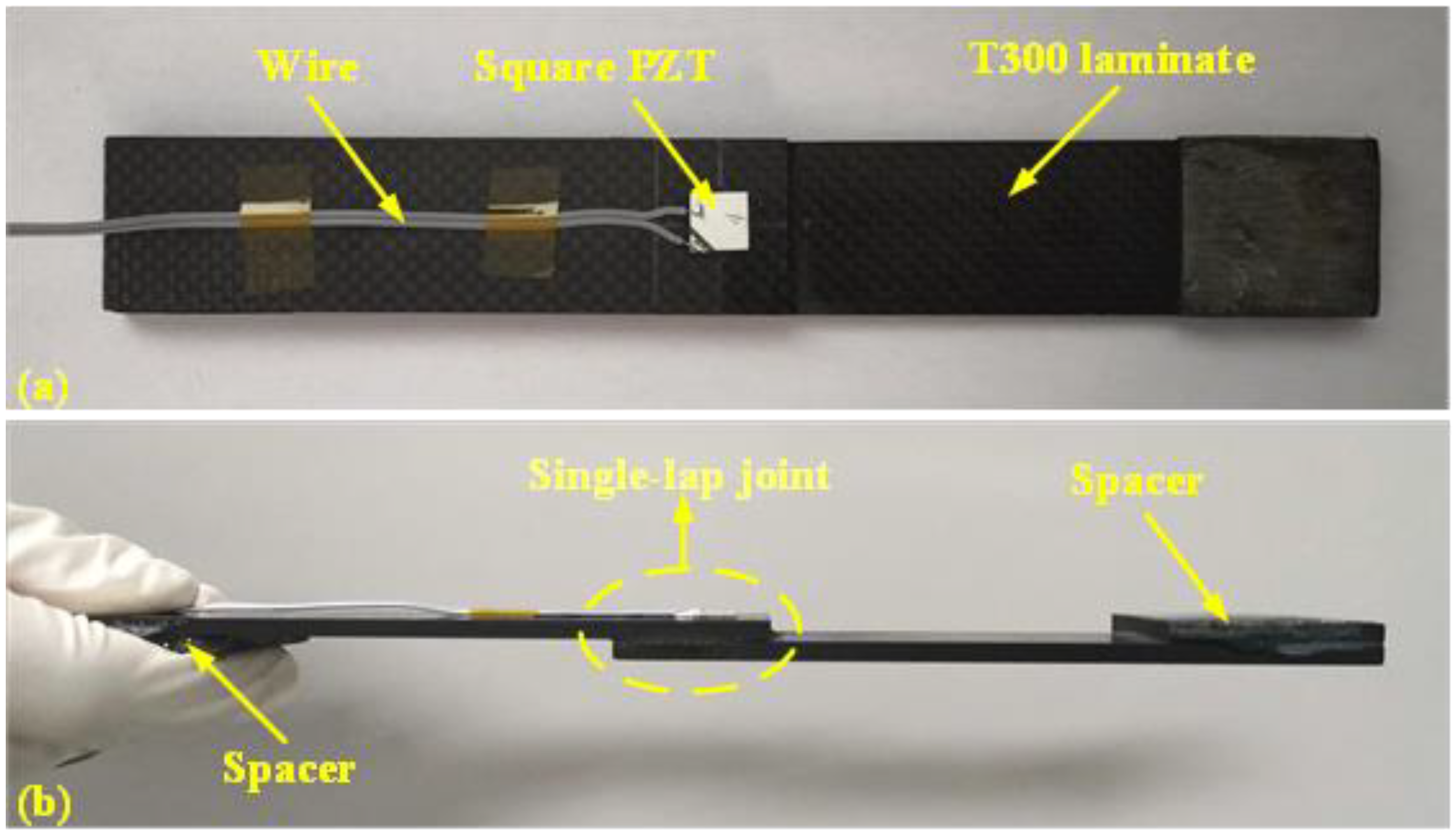
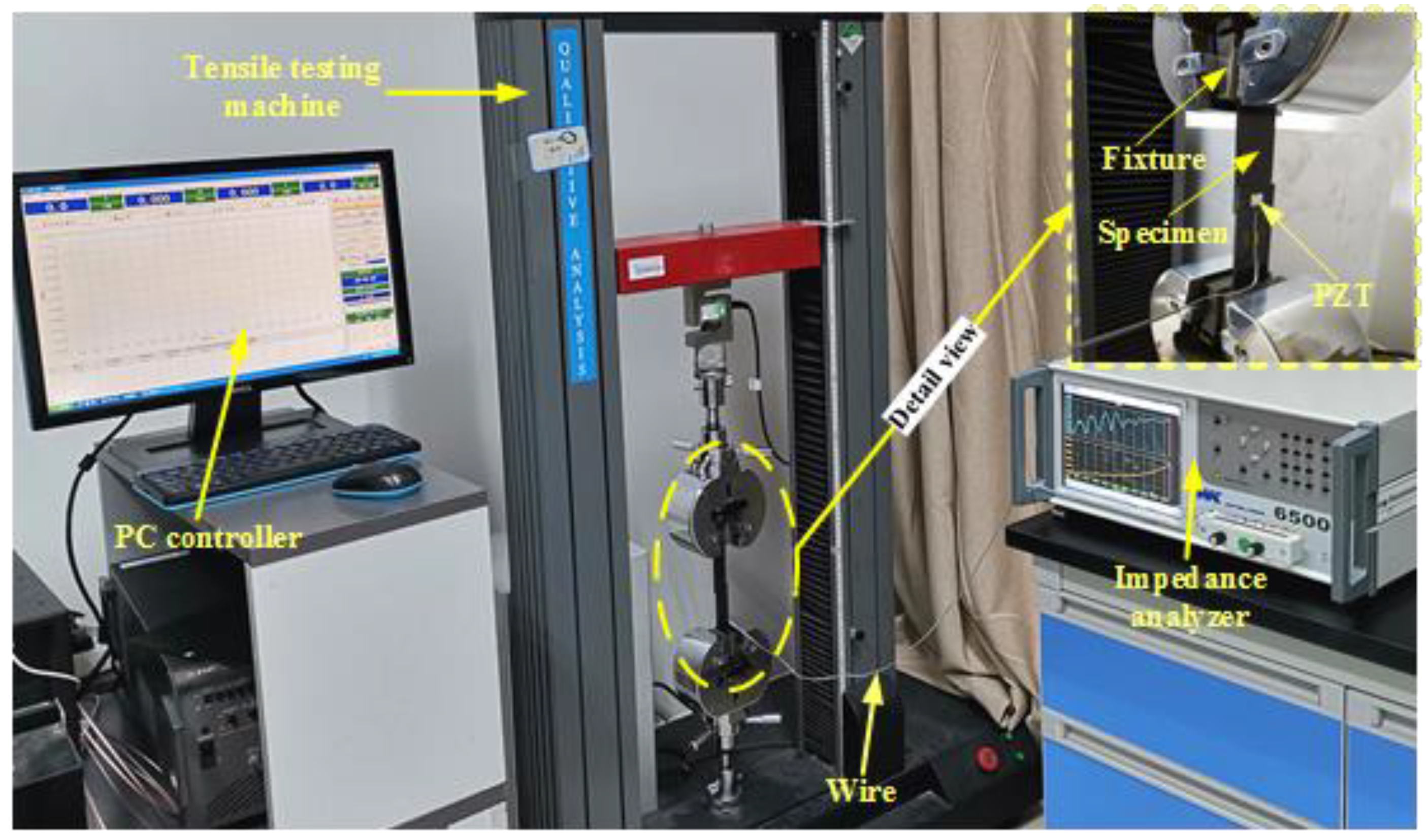
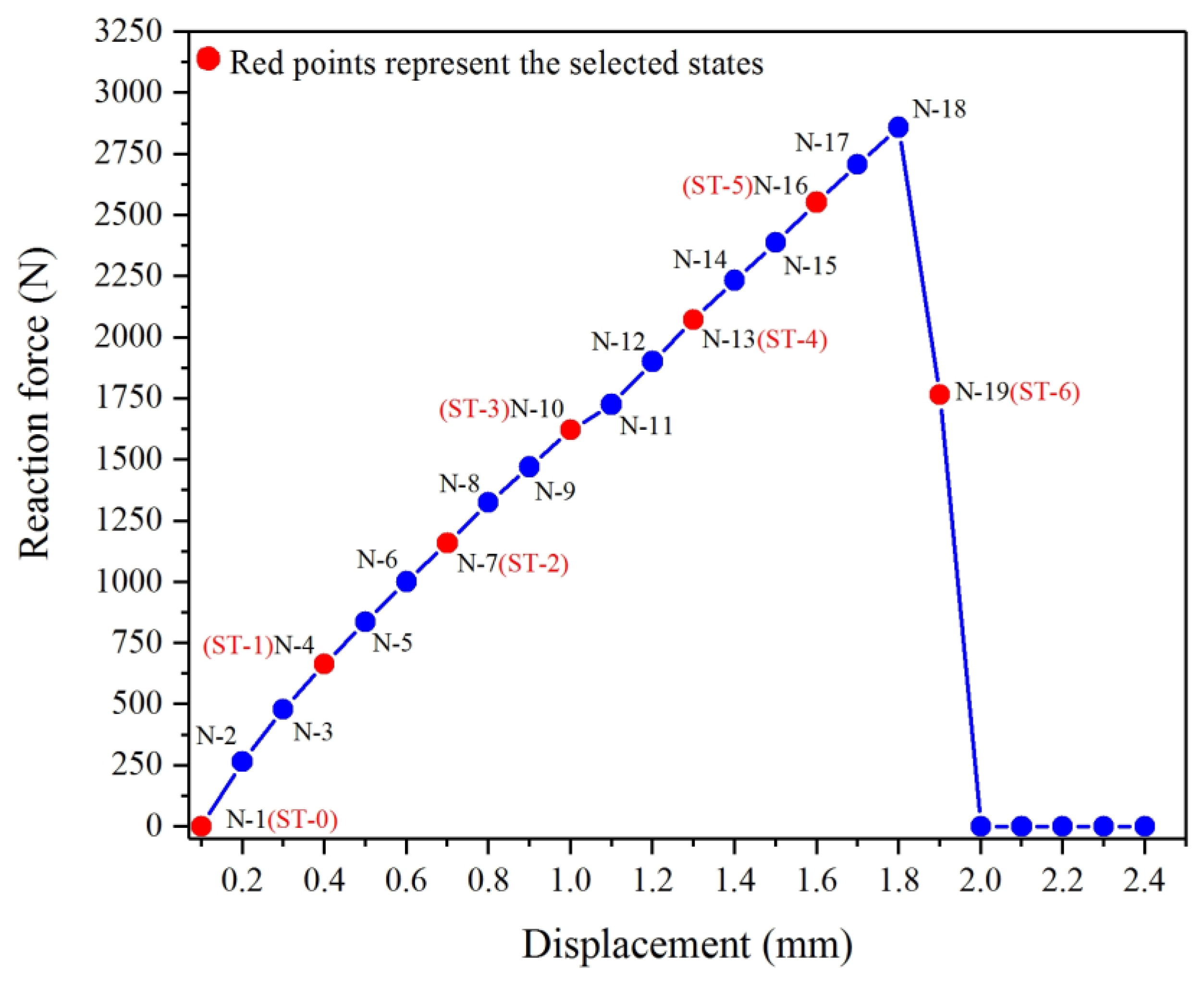
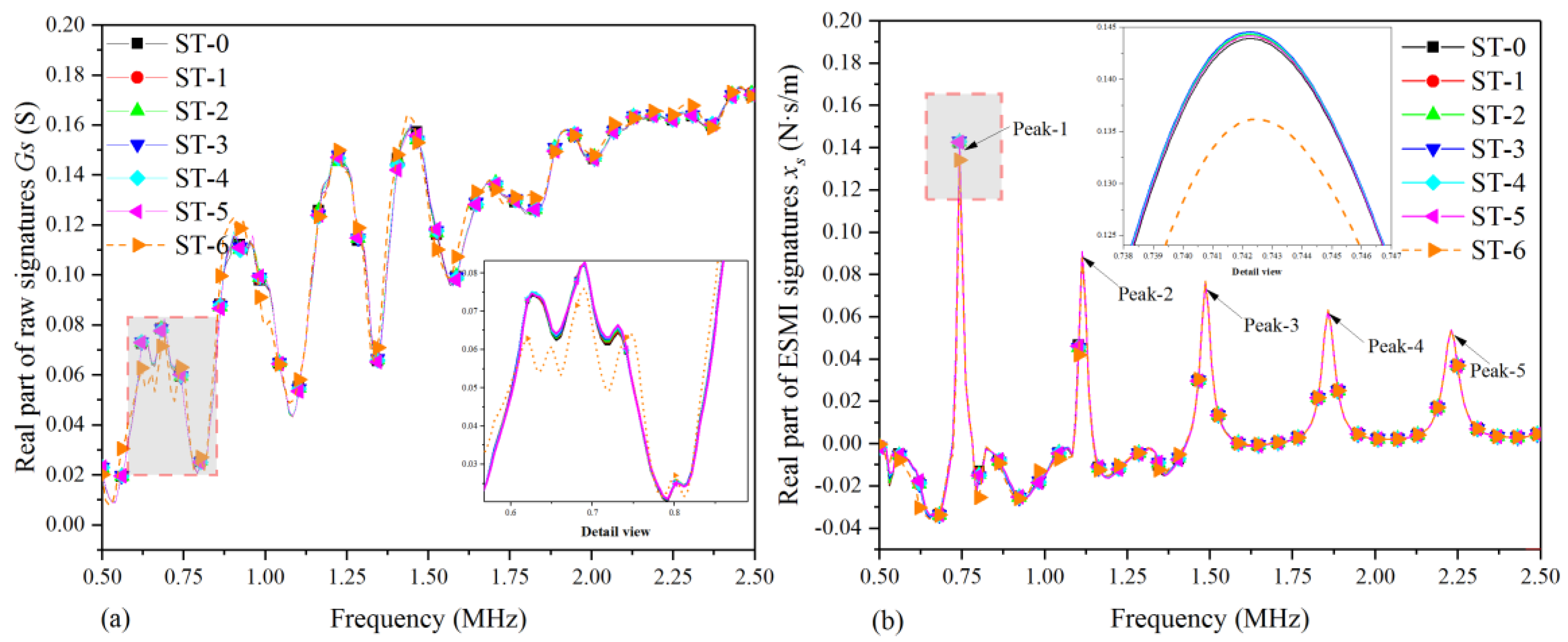
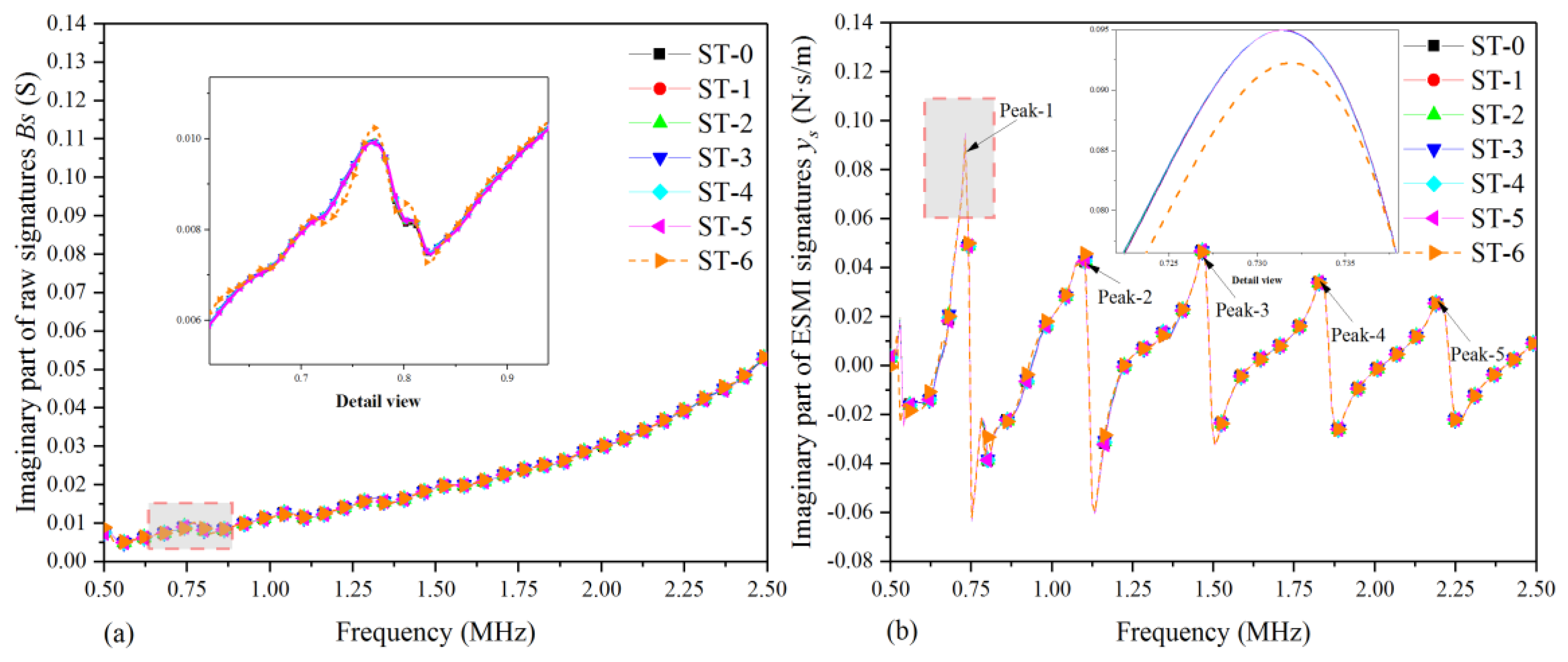
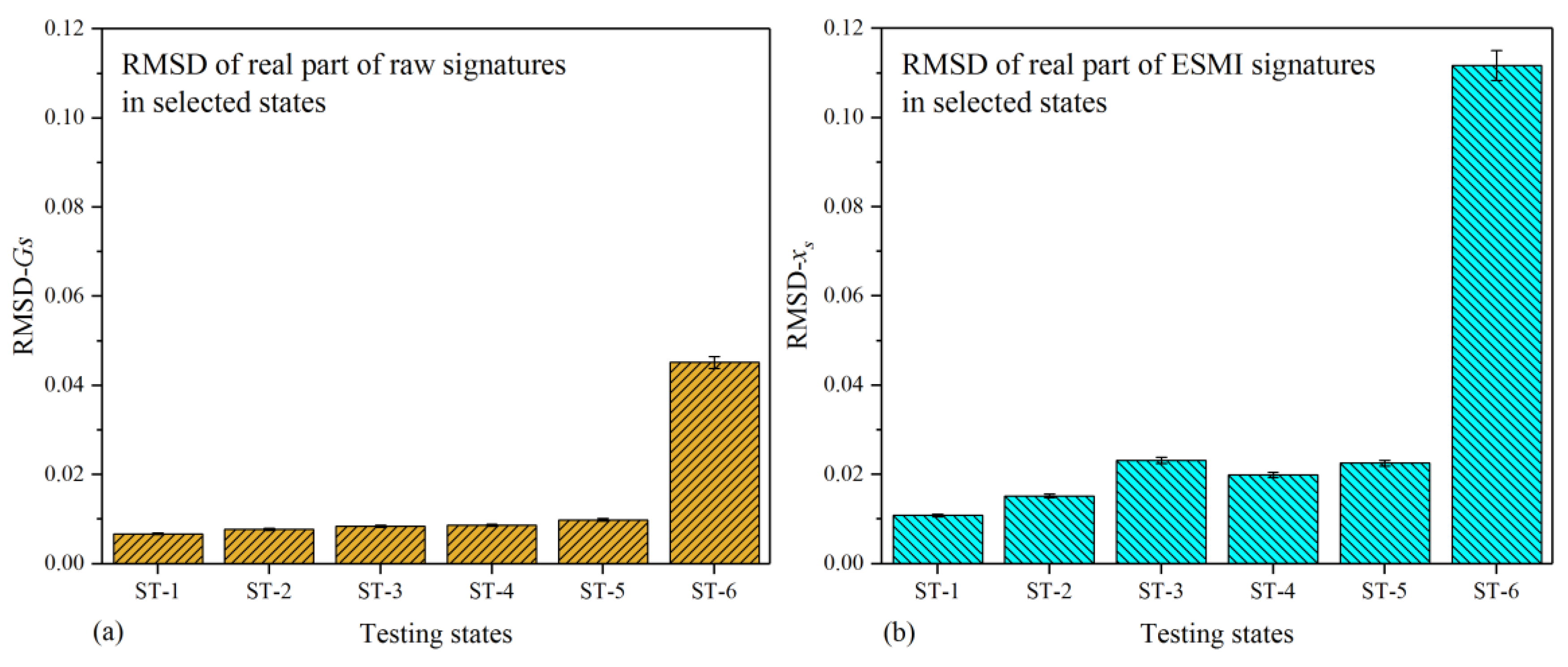
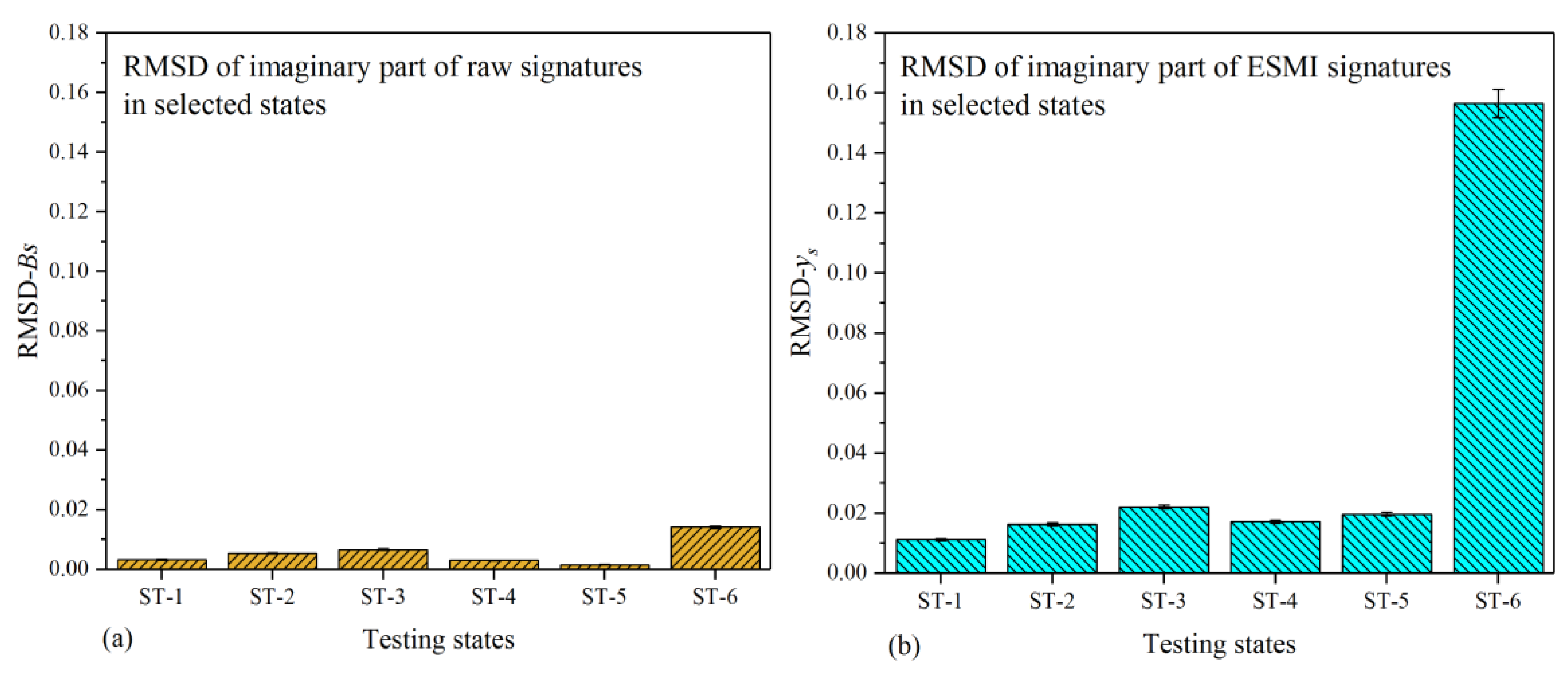
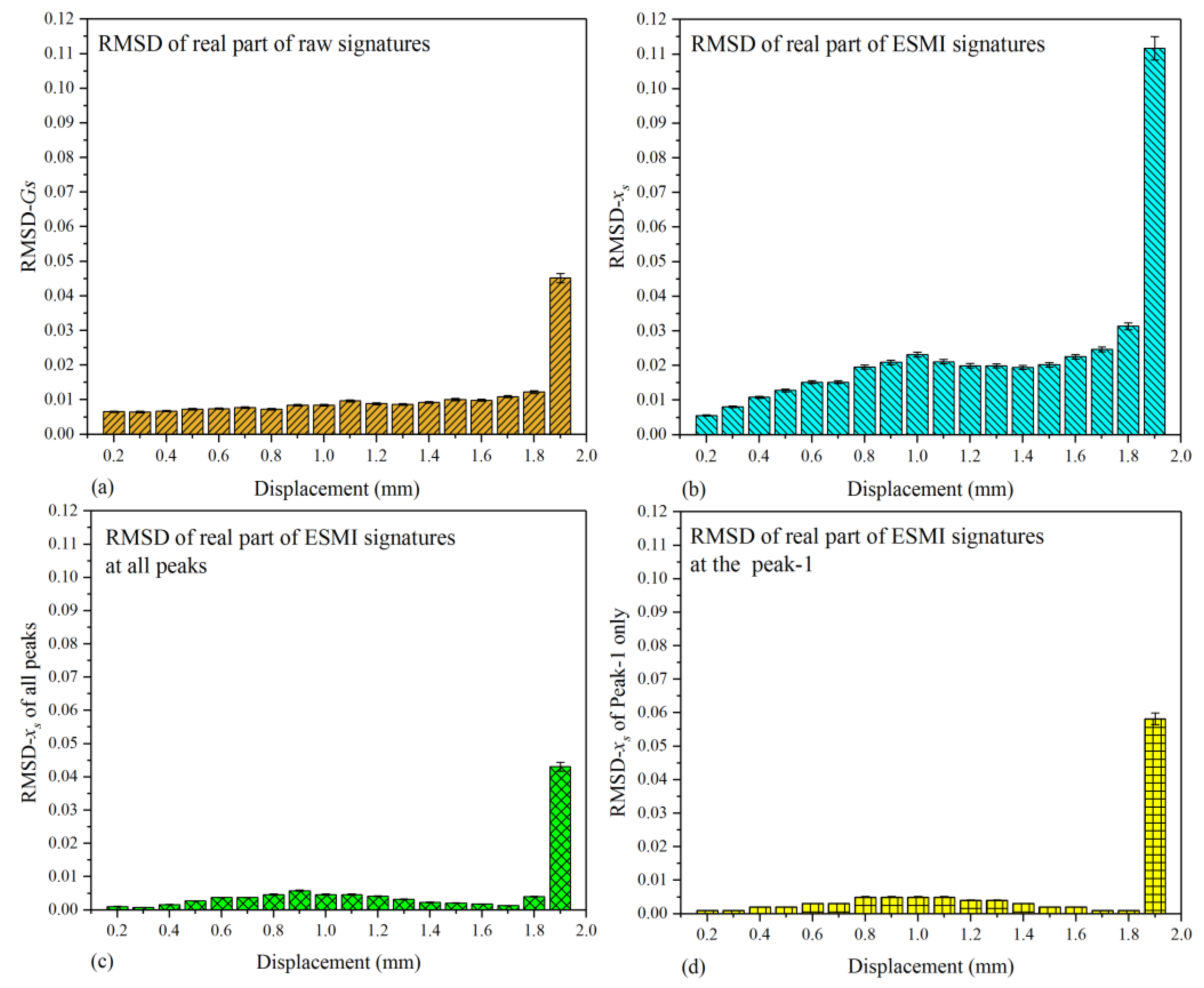
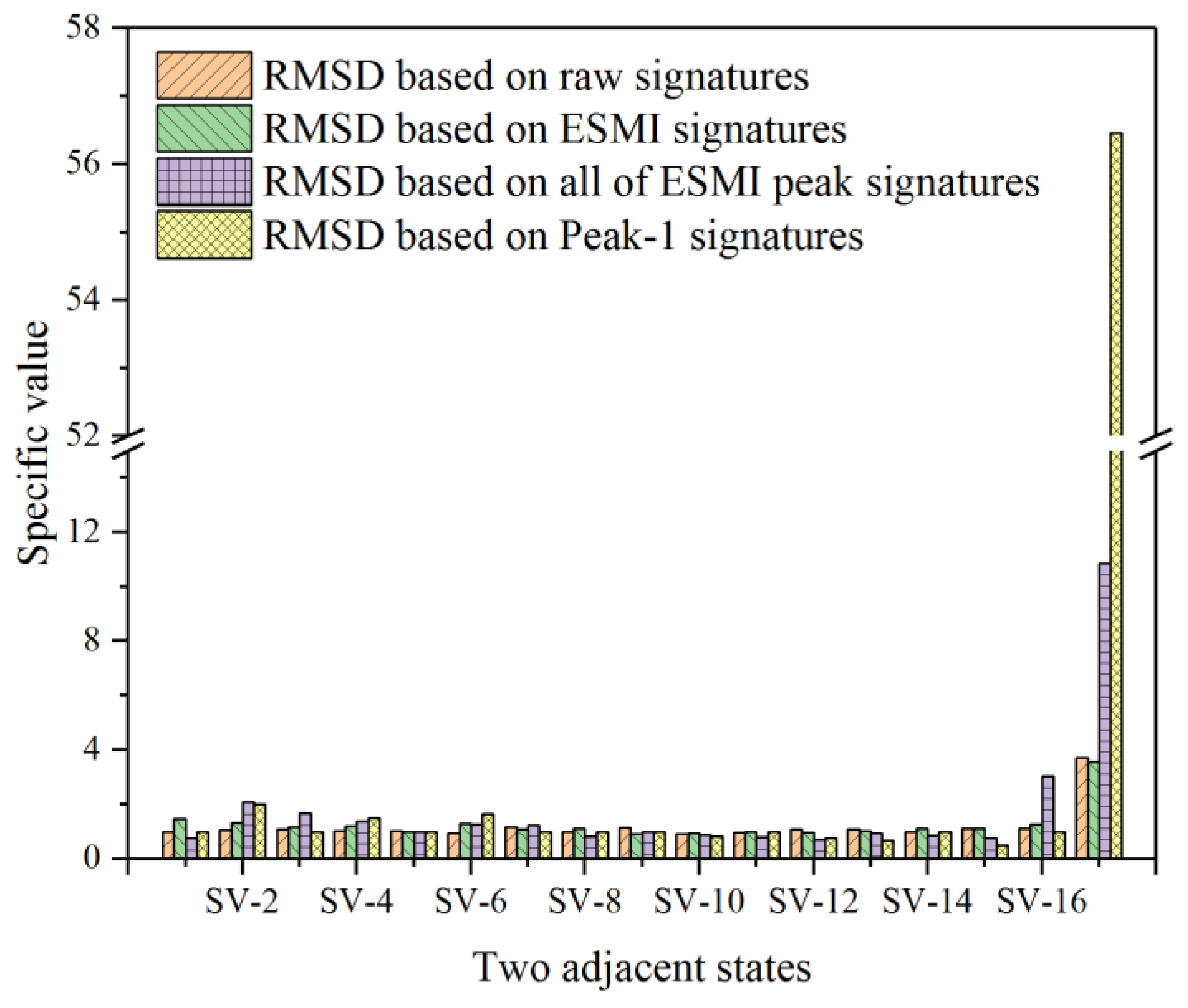
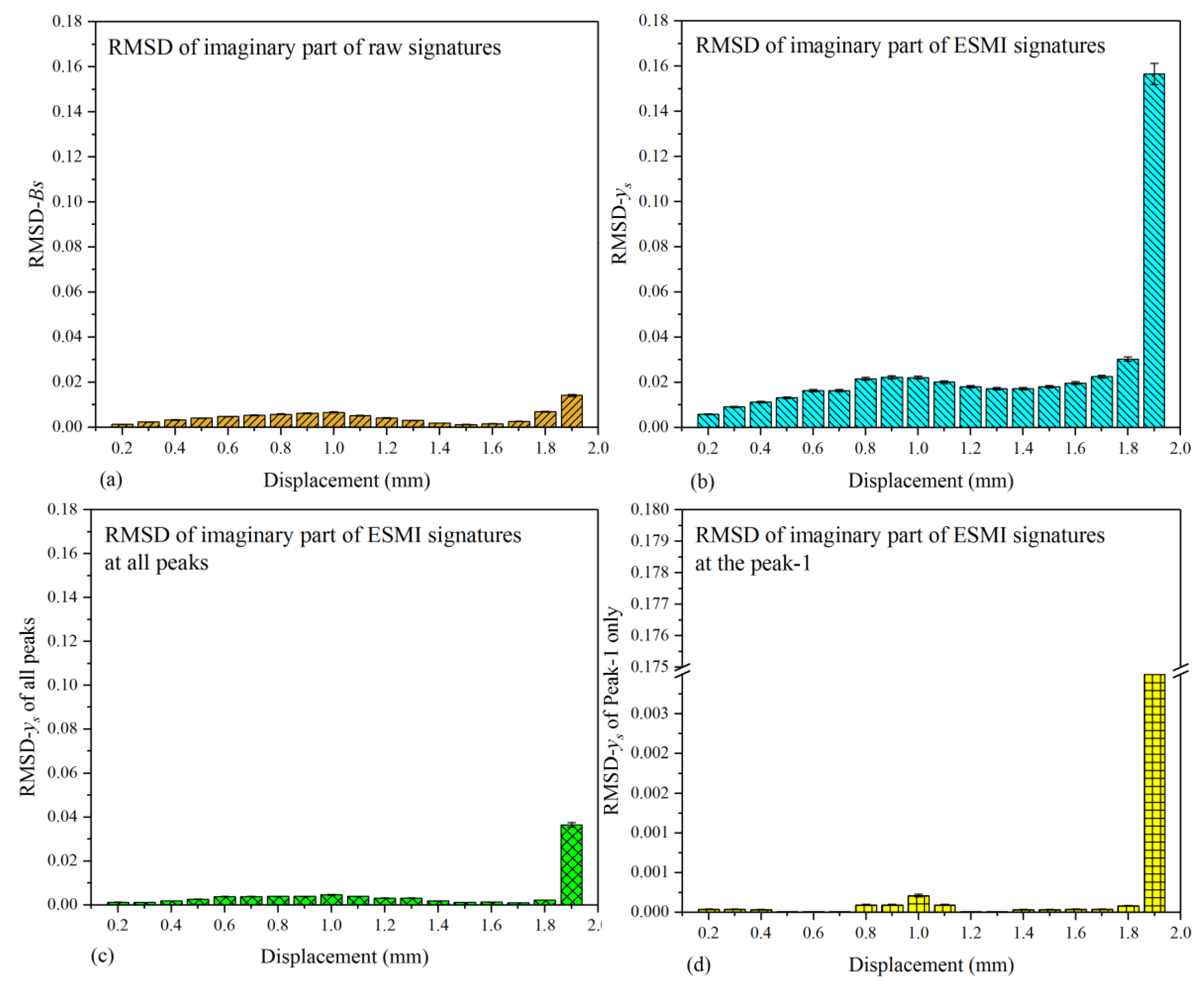
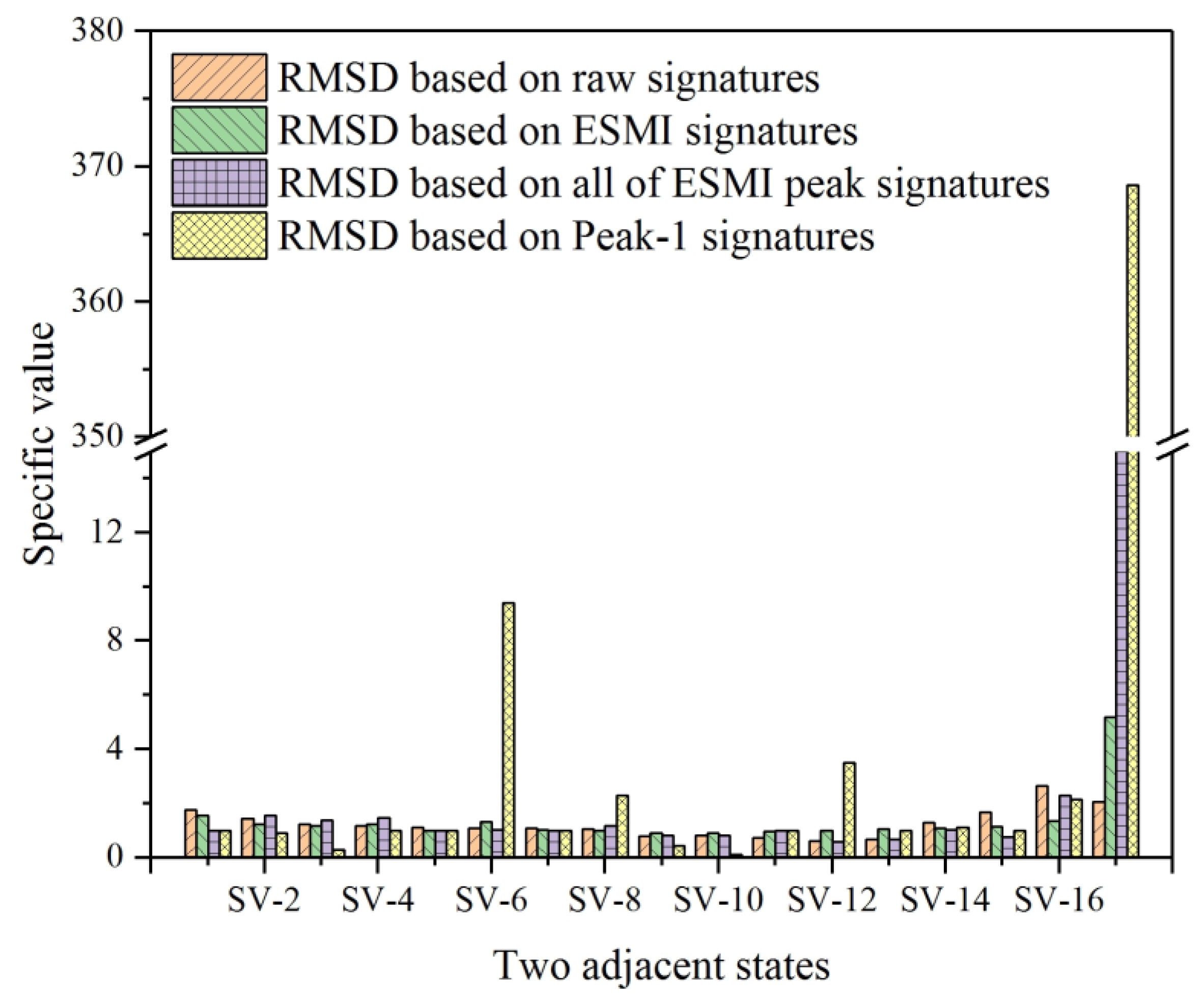
| Elastic constants | Physical parameters | Values |
|---|---|---|
| E1 (GPa) | Young’s modulus X-direction | 61.34 |
| E2 (GPa) | Young’s modulus Y-direction | 61.34 |
| E3 (GPa) | Young’s modulus Z-direction | 6.9 |
| ν12 | Poisson’s ratio XY | 0.04 |
| ν23 | Poisson’s ratio YZ | 0.3 |
| ν13 | Poisson’s ratio XZ | 0.3 |
| G12 (GPa) | Shear modulus XY | 19.5 |
| G23 (GPa) | Shear modulus YZ | 2.7 |
| G13 (GPa) | Shear modulus XZ | 2.7 |
| Parameters | Physical parameters | Values |
|---|---|---|
| Young’s modulus at constant electric field | 9.3 | |
| Mechanical loss factor | 0.01 | |
| Relative permittivity at constant stress | 1920 | |
| Dielectric loss factor | 0.025 | |
| Piezoelectric strain coefficient | −200 | |
| Poisson’s ratio | 0.32 | |
| Density | 7750 | |
| Thickness | 0.33 | |
| Length | 10 |
| Testing States | Displacement (mm) | Testing States | Displacement (mm) |
|---|---|---|---|
| N-1 (baseline) | 0.1 | N-11 | 1.1 |
| N-2 | 0.2 | N-12 | 1.2 |
| N-3 | 0.3 | N-13 | 1.3 |
| N-4 | 0.4 | N-14 | 1.4 |
| N-5 | 0.5 | N-15 | 1.5 |
| N-6 | 0.6 | N-16 | 1.6 |
| N-7 | 0.7 | N-17 | 1.7 |
| N-8 | 0.8 | N-18 | 1.8 |
| N-9 | 0.9 | N-19 (joint separation) | 1.9 |
| N-10 | 1.0 |
| Selected Testing States | Displacement (mm) | Notes |
|---|---|---|
| ST-0 | 0.1 | N-1 in original state |
| ST-1 | 0.4 | N-4 in original state |
| ST-2 | 0.7 | N-7 in original state |
| ST-3 | 1.0 | N-10 in original state |
| ST-4 | 1.3 | N-13 in original state |
| ST-5 | 1.6 | N-16 in original state |
| ST-6 (joint separation) | 1.9 | N-19 in original state |
© 2019 by the authors. Licensee MDPI, Basel, Switzerland. This article is an open access article distributed under the terms and conditions of the Creative Commons Attribution (CC BY) license (http://creativecommons.org/licenses/by/4.0/).
Share and Cite
Zhu, J.; Qing, X.; Liu, Q.; Liu, X.; Wang, Y. Monitoring of Fiber-Reinforced Composite Single-Lap Joint with Electromechanical Impedance of Piezoelectric Transducer. Materials 2019, 12, 3241. https://doi.org/10.3390/ma12193241
Zhu J, Qing X, Liu Q, Liu X, Wang Y. Monitoring of Fiber-Reinforced Composite Single-Lap Joint with Electromechanical Impedance of Piezoelectric Transducer. Materials. 2019; 12(19):3241. https://doi.org/10.3390/ma12193241
Chicago/Turabian StyleZhu, Jianjian, Xinlin Qing, Qijian Liu, Xiao Liu, and Yishou Wang. 2019. "Monitoring of Fiber-Reinforced Composite Single-Lap Joint with Electromechanical Impedance of Piezoelectric Transducer" Materials 12, no. 19: 3241. https://doi.org/10.3390/ma12193241
APA StyleZhu, J., Qing, X., Liu, Q., Liu, X., & Wang, Y. (2019). Monitoring of Fiber-Reinforced Composite Single-Lap Joint with Electromechanical Impedance of Piezoelectric Transducer. Materials, 12(19), 3241. https://doi.org/10.3390/ma12193241






